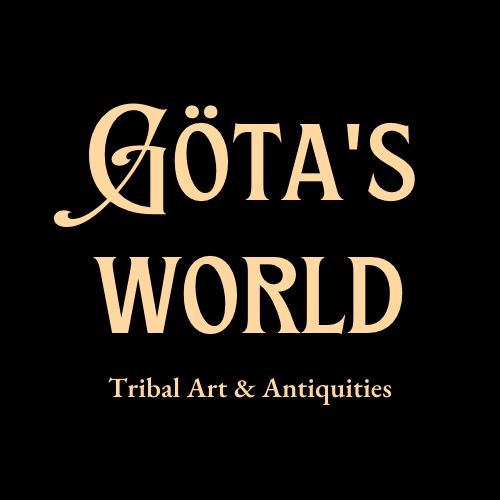Bakongo Power Figure Nkisi
Bakongo Power Figure Nkisi
Couldn't load pickup availability
Bakongo people, late 20th century, Democratic Republic of Congo, Central Africa
Fascinating small-sized power figure. Bakongo (also known Congo, Mkongo or Mukongo) are a Bantu ethnic group who speak the Kikongo language. Most art created by the Bakongo is spiritually driven often using sacred medicines, referred to as "Nkisi", for divine protection. Bakongo legends tells a story about the great god, Ne Kongo, who came down from heaven in a vessel and brought the first Nkisi. Nkisi (plural minkishi) are represented as a container filled with sacred material that is triggered by supernatural forces which can be summoned into physical world. Nkisi can be as simple as pottery containing herbs or as complex as wooden figures imbued with sacred elements.
Wooden figures are called Nkisi Nkondi. Word "Nkondi" means "hunter". The empowering spirits of minkishi come from the land of dead (nsi a bafwa), where the four classes of the dead include ancestors (bakulu), local spirits (bisimbi, bankita), ghosts (minkuyu) and those that voluntery or otherwise are present in nkisi objects. All minkisi are classified by their cosmological domain of operation, which corresponds to their function, broadly defined. The domains are those of "the above" (ku zulu) and "the below" (ku nsi), meaning the sky and celestial waters as opposed to the earth and terrestrial waters. The primary function of nkondi is to be the home of spirit which can travel out from its base, hunt down and harm other people. Many nkondi were publicly held and were used to affirm oaths, or to protect villages and other locations from witches or evildoers.
Nkisi Nkondi are often representing a human or animal, such as a dog (Nkisi nkondi kozo) carved under the divine authority and in consultation with an Nganga or spiritual specialist who activates these figures through chants, prayers and the preparation of sacred substances which are aimed at ”curing” physical, social or spiritual ailments. The nganga gathers sacred medicine (bilongo), which when assembled, will become the home of the spirit. A container such as a wooden figure or a calabash is not a nkisi until bilongo have been included in it. The most common place for storage bilongo are the belly or chest where it’s hidden under resin-fixed mirror or glass, which represents the ”other world” and the reflective surface enabled the nkisi to see in the spirit world in order to spy out its prey. Small pouches or packs bilongo are also frequently placed on the head or surrounding the neck. Alternatively, a client of the nkisi may include parts of his own body or clothing in little pouch (mfunya) attached to the nkisi. In complementary usage, the mfunya attached to the nkisi contains relics of the wrongdoer himself and of his ill deed, so that the nkisi may know just whom to pursue. Another name for mfunya is dog (mbva).
To drive the nkondi into action, nganga diviners must invoke and provoke the spirit that resides in the figure. Gunpowder is first exploded in front of the figure to annoy and arouse the nkondi into action. Nails and metal blades are then hammered in the figure to make spirit angry towards the clients enemy for the wounds inflicted on its body. The nails are also used as a symbol of the pain the nkondi must inflict on the specified target. This process of nkondi provocation and invocation is known as koma loko (meaning ”to nail a curse”), or simply nailing (nkomono). Not all such procedures in fact involve nails, and many nkondi are not nailed, nor do they include wooden figures into which nails could be driven. A common way of arousing nkondi's anger, with or without nails, is to insult it.
Small-sized vintage Nkisi Nkondi with hammered rusty nails, twine cord, basketry fragments and textile stripes. Carved bilongo cavity in the belly area, hidden under clay and cowrie shell. Encrusted coating of graveyard dirt (mpemba) covers the surface. The facial features are well-carved. The figure stands on the square pedestal. Good condition. Chip and cracks. Size approx. 32,5cm x 16,0cm x 15,0cm.
Provenance: Dutch private collection
References and further reading:
Nkisi Figures of the Lower Congo, Zdenka Volavkova, African Arts, Vol.5, No.2, pp.52-59+84, Published by UCLA, Winter 1972.
Astonishment and power, David C. Driskell, Michael D. Harris, Wyatt Macgaffey & Sylvia H. Williams, National Museum of African Art, Smithsonian Institution Press, 1993.
The Personhood of Ritual Objects: Kongo "Minkisi", Wyatt Macgaffey, Etnofoor, Jaarg.3, Nr.1, Fetishism, pp. 45-61, 1990.
Franchising minkisi in Loango: Questions of form and function, Wyatt Macgaffey, Anthropology and Aesthetics, Published by The University of Chicago Press on behalf of the Peabody Museum of Archaeology and Ethnology, No. 65/66, pp.148-157, 2014/2015.
Power Figure (Nkisi Nkondi), Kongo peoples, Dr. Shawnya L. Harris & Dr. Peri Klemm, Smarthistory, The Center For Public Art History.




-
Shipping
The shipment will be prepared in the course of 3-5 days and dispatched via Posti Group Oyj or purchased item(s) can be picked up from our shop during the store's opening hours (Tarkk’ampujankatu 4, 00140, Helsinki, Finland). Within the Finland, all items are shipped via Posti Group Oyj unless otherwise requested. We pack the items carefully and mainly in recycled materials because we want to save nature. You will receive the tracking number for your items by e-mail.
-
Returns
Returns and exchange will be accepted within fourteen days (14) of receipt at the purchaser’s cost to include freight and packaging. Items must be returned in the same condition as when they were shipped, and will not be accepted if damaged or altered in any way. Please inform us via email (info@gotanmaailma.fi) or by calling +358408408352 before sending. We do not accept returns more than 14 days after delivery.




